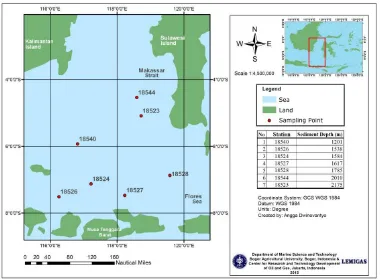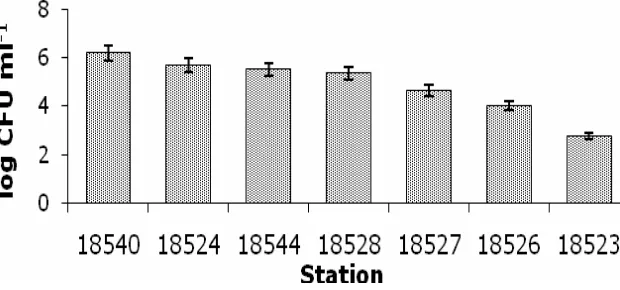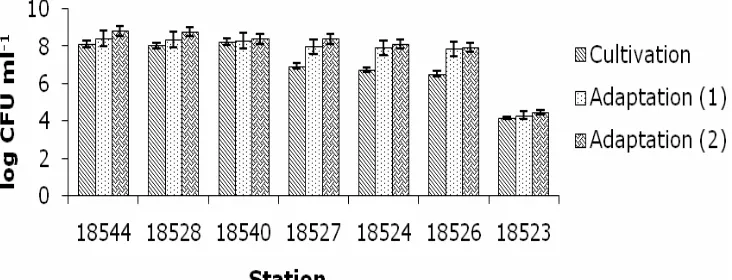ELBA BI OFLUX
1Department of Marine Science and Technology, Faculty of Fisheries and Marine Science,
Bogor Agricultural University, Bogor, Indonesia; 2Laboratory of Biotechnology, Center for
Research and Technology Development of Oil and Gas – Ministry of Energy and Mineral Resources, Jakarta, Indonesia; 3Center for Environmental Research, Bogor Agricultural
University, Indonesia. Corresponding author: T. Prartono, tripr@ipb.ac.id
Abst r a ct. The potency of deep-sea sediments bacteria is still unfamiliarly used for oil spill biodegradation, and this research was to isolate and identify bacteria from those sediments and adapt them in oily media. Bacterial isolates were cultivated and adapted in a mixture of 0.1% v/v crude oil media. Seven deep-sea sediment samples were treated to isolate bacteria and it produced a variety of bacteria population 5.5 x 102
CFU mL-1
to 1.5 x 106
CFU mL-1
. These populations apparently increased after cultivation and adaptation and gave a varying population from 3.0 x 106
CFU mL-1
to 6.8 x 108
CFU mL-1. The increased bacteria population was an indication of the bacterial capability of using carbon in
crude oil as a substrate. Those bacteria were Raoult ella sp., Ent erobact er sp. and Pseudom onas sp.
Ke y w or ds:Bacteria, biodegradation, deep-sea sediment, isolation, oil spill.
Abst r a k. Potensi bakteri sedimen laut dalam untuk teknologi biodegradasi tumpahan minyak masih belum banyak dimanfaatkan. Tujuan dari penelitian ini adalah mengisolasi dan mengidentifikasi bakteri alami dari contoh sedimen laut dalam, dan menyesuaikannya dalam media yang berminyak. Isolat bakteri dikultivasi dan diadaptasi menggunakan media air laut terkondisi nutrien yang dicampur dengan minyak mentah 0.1% v/v. Isolasi dari 7 contoh sedimen laut dalam menghasilkan jumlah populasi bakteri 5.5 x 102
CFU mL-1
hingga 1.5 x 106
CFU mL-1
. Setelah kultivasi dan adaptasi dilakukan, populasi bakteri meningkat yaitu sebesar 3.0 x 106
CFU mL-1
hingga 6.8 x 108
CFU mL-1
. Peningkatan tersebut mengindikasikan bahwa bakteri mampu menggunakan karbon pada minyak mentah sebagai sumber nutrisi. Bakteri yang teridentifikasi dalam penelitian ini diantaranya Raoult ella sp., Ent erobact er sp. dan
Pseudom onas sp.
Ka t a k u n ci: Bakteri, biodegradasi, isolasi, sedimen laut dalam, tumpahan minyak.
Re z u m a t.Capacitatea bacteriilor din sedimentele din profunzimile marine este încă puţin utilizată pentru biodegradarea deversărilor de petrol, iar acest studiu vizează izolarea şi identificarea bacteriilor din aceste sedimente, şi adaptarea lor la mediul petrolier. Probe bacteriene au fost cultivate şi adaptate într-un amestec de 0.1% v/v mediu petrolier brut. Şapte probe sedimentare din profunzimile marine au fost folosite pentru a izola bacteriile şi au rezultat o varietate de populaţii bacteriene de la 5.5 x 102
CFU mL-1
la 1.5 x 106 CFU mL-1. Aceste populaţii s-au înmulţit evident după cultivare şi adaptare, şi au ajuns la o
variaţie de la 3.0 x 106 CFU mL-1 la 6.8 x 108 CFU mL-1. Amplificarea populaţiei bacteriene a indicat
capacitatea bacteriană în ce priveşte folosirea carbonului din petrolul brut ca şi substrat. Aceste bacterii au fost specii de tipul Raoult ella sp., Ent erobact er sp.şi Pseudom onas sp.
Cu vin t e ch e ie:bacterii, biodegradare, sediment din profunzimi marine, izolare, deversare petrolieră.
Bioremediation as a technique of using petroleum degrading bacteria is a relatively inexpensive, efficient solution and easy to apply, besides no further impact to marine environment (Thapa et al 2012). The utilization of local marine bacteria from the water column has been tested in various environments (Nashikin & Shovitri 2013; Darmayati 2009; Nababan 2008). Naturally, bacteria are able to degrade complex hydrocarbons such as long chain hydrocarbons (n-alkane) and polyaromatic hydrocarbon (Sari 2007). The bacteria use hydrocarbons as a source of carbon and energy to develop (Thapa et al 2012). Some examples of degrading bacteria are Pseudom onas aeruginosa, Bacillus subt ilis, and Acinet obact er lwoffi, which were able to degrade aliphatic crude oil by 77.8%, 76.7%, and 74.3%, respectively (Al-Wasify & Hamed 2014).
Sediment as a source of bacterial isolates is a complex habitat with a number of organic materials lucrative for growing bacteria. The organic material in marine sediments derives from the residual feed, decomposed dead animals and plants, and nutrients particles precipitated by their gravity (Rampen et al 2012). Hence, the sediment has more potential content of bacteria compared with sea water. This study was to isolate and identify bacteria from deep-sea sediments and to test their adaptation in oily environment.
M a t e r ia l a n d M e t hods
Se dim e nt sa m pling. Deep sea sediment samples from seven locations at ~ 1000 meter depth of Indonesian Makassar Strait to Flores Sea were collected using gravity cores in July-August 2011 (Figure 1). All core samples were then kept in at 4 ºC during transportation and their storage in the laboratory for further analysis.
Figure 1. Location Map of the deep-sea sediment sampling.
I sola t ion of cr u de oil de gr a din g ba ct e r ia. The isolation was based on the method developed by Mendham et al 2000 and Atlas 2010. 1 mL of the inoculum containing water was pipetted and transferred into a test containing 9 mL physiological solution (NaCl 9%) and mixed. The mixture was consecutively diluted three times with ratios of 1:9 for each dilution tubes. 0.1 ml of each mixture tube was pipetted and transferred into four Petri dishes containing 10-15 mL plate count agar (PCA). These four Petri dishes were incubated for three days to allow bacteria to develop. All of these processes were conducted in a laminar flow bench to avoid contamination. Total plate count (TPC) was determined by colony-forming-unit mL-1 (CFU mL-1) (APHA 2012).
Ba ct e r ia l cu lt iva t ion. Bacteria were developed by collecting isolate from Petri dish and transferred in 100 mL nutrient broth (NB) liquid medium. The culture was shaken at 120 rpm for 48 hours at room temperature. The bacteria growths were signed by changes of color and being more turbid in the liquid media. 0.1 mL of this culture was poured into the Petri dish and left for three days incubation (Okoro 2010). The bacterial populations were counted by TPC (APHA 2012).
Ba ct e r ia l a da pt a t ion.10 mL bacterial culture aliquot and crude oil (concentration 0.1% v/v) were poured into 100 mL nutrient-conditioning sea water. The composition of nutrient was 1.26 g MgSO4.7H2O, 1 g KCl, 2.5 g KH2PO4, 3.75 g Na2HPO4, and 1.29 g
NaNO3 dissolved in 3 liter sterile sea water (Okoro 2010). The mixture was shaken at 120
rpm for 72 hours in room temperature. Bacteria population was counted by optical density (Razika et al 2010). When the population was >106 CFU mL-1, the bacteria could
be used for biodegradation processes (Okoro 2010).
Ba ct e r ia l ide n t ifica t ion.Identification of isolated bacteria was based on the Biolog Gen III identification system (Biolog Inc., USA). Pure isolates of the adapted bacteria were developed into a nutrient agar (NA) medium. This media was then transferred into a solution of G-negative bacteria inoculation fluid. This solution was measured by Biolog turbidimeter to indicate bacterial content. 150 µL of this solution was then pipetted and put into the GN2 MicroPlateTM and incubated for 16-24 hours. The plate was determined
by MicroStation Microplate Reader. The identification process was run by a pre-loaded database ID on a computer. Bacterial species appeared on the monitor in the form of 1-10 species that have an adjacent reaction pattern with the percentage of similarity (Wragg et al 2014).
Re su lt s a n d D iscu ssion.The visual characteristics of the marine sediments were green, dark green, brownish-green, and dark brown (Table 1). This could reflect the extent of sedimentary oxidation; brown color was more oxidative; although no relationship between the depth of sediment and the oxidation level was observed.
Table 1 Visual characteristics of marine sediment in each station
No Station Depth (m) Characteristics of sediment
1 18540 1201 Green mud
2 18524 1584 Dark green mud
3 18544 2010 Brownish-green mud
4 18528 1785 Dark green mud
5 18527 1617 Brownish-green mud
6 18526 1538 Green mud
The number of bacteria isolated varied from the highest bacterial population of 1.5 x 106 CFU mL-1,which was obtained at the Station 18540 to the lowest, 5.5 x 102 CFU mL-1,
which was obtained at the Station 18523 (Figure 2). The differences in number of population at each station could possibly be related to the availability of bacteria in sediment samples and sample handling.
Figure 2. Total population of bacteria in 7 sediment samples.
Bacterial isolates were cultivated and adapted to environmental conditions containing small volume of oil. Cultivation processes were performed to regenerate and multiply the number of bacterial populations. The experiment showed that bacteria was able to develop after 48 hours, and those, visually, were indicated by the changes of color from pale yellow (as initial) to green or orange (Figure 3).
Figure 3. Color change in bacteria cultivation.
The color changes to yellow occurred in the samples of Station 18540, 18528, 18524, 18523; changing to orange occurred in the samples of Station 18524, 18527; and to green occurred in the sample of Station 18544. Color change indicated bacterial response to media as a result of secondary metabolites produced by bacterial pigments (Ahmad et al 2012). The increase of bacterial population would give more turbid and concentrated color in the solution, as shown in the sample solution of Stations 18540.
Figure 4. Bacterial population growth after cultivation and adaptation process.
Identification was only performed on bacterial isolates having the highest number of population (e.g. sample from Stations 18544). Bacteria identified during the study were Raoult ella sp., Ent erobact er sp. and Pseudom onas sp., which were attained through matrix-assisted laser desorption ionization-time of flight mass spectrometry used in Biolog GEN III identification system. Rodrigues et al (2008) reported that Raoult ella could degrade toluene, xylene, naphthalene, and n-alkanes compounds. Ent erobact er is able to degrade oil and used as a biosurfactant. Ent erobact er effectively degraded crude oil at pH 7 and temperature of 30 ºC (Ahmed et al 2014). Dawson & Chang (1992) reported that Pseudom onas has a specific enzyme to break aliphatic and aromatic hydrocarbon compounds. These bacteria have been found in the Makassar Strait (Damayati 2009).
Con clu sions. Raoult ella sp., Ent erobact er sp. and Pseudom onas sp. were predominantly found in seven deep-sea sediment samples with varying populations. These bacteria were able to adapt to the oily culture media and suggested to have potential for oil-biodegradation processes.
Ack n ow le dge m e n t s. The authors would like to extend their gratitude to Center for Research and Technology Development of Oil and Gas - Ministry of Energy and Mineral Resources for its financial support on this project. In addition, we thank to Laboratory of Microbiology, Faculty of Medical Science, University of Indonesia, and Department of Marine Science and Technology, Bogor Agricultural University.
Re fe r e n ce s
Ahmad W.A., Ahmad W.Y.W., Zakaria Z.A., 2012 Application of bacterial pigments as colorant. Mol Sci 25-44. doi: 10.1007/978-3-642-24520-6_2.
Ahmed A.W., Alzubaidi F.S., Hamza S.J., 2014 Biodegradation of crude oil in contaminated water by local isolates of Ent erobact er cloacae. J Sci 55(3):1025-1033. Al-Wasify R.S., Hamed S.R., 2014 Bacterial biodegradation of crude oil using local
isolates. J Microbiol 1-8. doi:10.1155/2014/863272.
American Public Health Association (APHA), 2012 Total Plate Count. Standard Methods for the Examination of Water and Wastewater 22nd (ed).
Atlas R.M. 2010 Handbook of Microbiological Media 4th ed, p 1403, CRC Press, Boca Raton.
Darmayati Y., 2009 Development of oil bioremediation research on marine environment in Indonesia. Coast Dev 12(3):105-110.
Dawson T., Chang F.H., 1992 Screening test of the biodegradative capability of a new strain of Pseudom onas gladioli (BSU 45124) on some xenobiotic organics. Environ Contam Toxicol 49(1):1-10.
Nababan B., 2008 Isolation and test the potential of diesel oil degrading bacteria from Belawan Sea. University of Northern Sumatera, Medan.
Nashikin R., Shovitri M., 2013 Isolation and characterization of diesel and gasoline degrading bacteria of Water Port Gresik. J Sci 2(2):2337-3520.
Nugroho A., 2006 Biodegradation of oil sludge in microcosm scale: Simulation simple as bioremediation land treatment initial assessment. Makara J Tek 10(2):82-89.
Okoro C.C., 2010 Enchanced bioremediation of hydrocarbon contaminated mangrove swamp in the Nigerian oil rich Niger Delta using seawater microbial inocula amended with crude biosurfactants and micronutrients. Nat Sci 8(8):195-206.
Rampen S.W., Sinninghe-Damste J.S., Schouten S., Middelburg J.J., 2012 Characterization of the deep-sea microbial community and investigation of their carbon sources using lipid biomarkers. Oceanogr Biol Chem 84:204-216. doi:10.1016/j.gca. 2012.01.024
Razika B., Abbes B., Messaoud C., Soufi K., 2010 Phenol and benzoic acid degradation by Pseudom onas aeruginosa. J Water Resource Prot 2:788-791. doi: 10.4236/jwarp.2010.29092.
Rodrigues D.F., Sakata S.K., Comesseto J.V., Bicego M.C., Pellizari V.H., 2008 Diversity
of hydrocarbon-degrading Raoult ella isolated from hydrocarbon-contaminated
estuaries. J Appl Microbiol 106:1304-1314. doi:10.1111/j.1365-2672.2008.04097.x Sari S.H.J., 2007 Decomposition abilities of petroleum hydrocarbons in sediments by
Klabsiella sp. ICBB 7866 bacteria. Bogor Agricultural University, Bogor.
Thapa B., Ajay K.K.C., Ghimire A., 2012 A Review on bioremediation of pertoleum hydrocarbon contaminant in soil. J Sci Eng Tech 8(1):164-170.
United States Environmental Protection Agency (US EPA), 2014 The Fate of Spilled Oil. Understanding Oil Spills and Oil Spill Response.
Wragg P., Randall L., Whatmore A.M., 2014 Comparison of Biolog GEN III MicroStation semi-automated bacterial identification system with matrix-assisted laser desorption ionization-time of flight mass spectrometry and 16S ribosomal RNA gene sequencing for the identification of bacteria of veterinary interest. J Microbiol 105:16-21.
Received: 19 August 2015. Accepted: 18 September 2015. Published online: 27 October 2015. Authors:
Angga Dwinovantyo, Department of Marine Science and Technology, Faculty of Fisheries and Marine Science, Bogor Agricultural University, Dramaga, Bogor 16680, Indonesia, e-mail: anggano@gmail.com
Tri Prartono, Department of Marine Science and Technology, Faculty of Fisheries and Marine Science, Bogor Agricultural University, Dramaga, Bogor 16680, Indonesia, e-mail: tripr@ipb.ac.id, triprartono@gmail.com
S. Syafrizal, Laboratory of Biotechnology, Center for Research and Technology Development of Oil and Gas – Ministry of Energy and Mineral Resources, Jakarta, Indonesia, e-mail: syafrizal.ia@gmail.com
U. Udiharto, Laboratory of Biotechnology, Center for Research and Technology Development of Oil and Gas – Ministry of Energy and Mineral Resources, Jakarta, Indonesia, e-mail: udiharto@lemigas.esdm.go.id
Hefni Effendi, Center for Environmental Research, Bogor Agricultural University, Dramaga, Bogor 16680, Indonesia, e-mail: hefni_effendi@yahoo.com
This is an open-access article distributed under the terms of the Creative Commons Attribution License, which permits unrestricted use, distribution and reproduction in any medium, provided the original author and source are credited.
How to cite this article:



